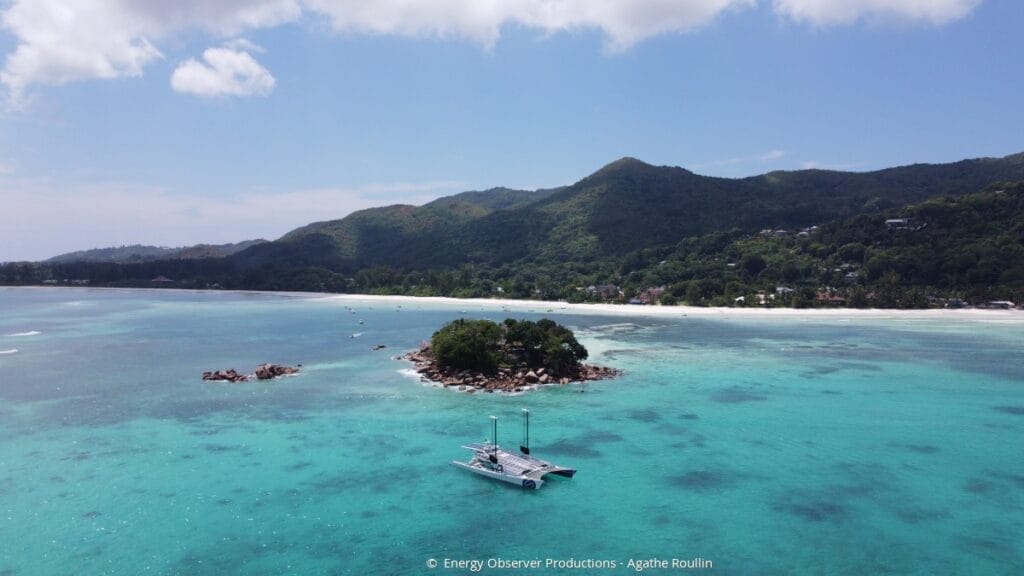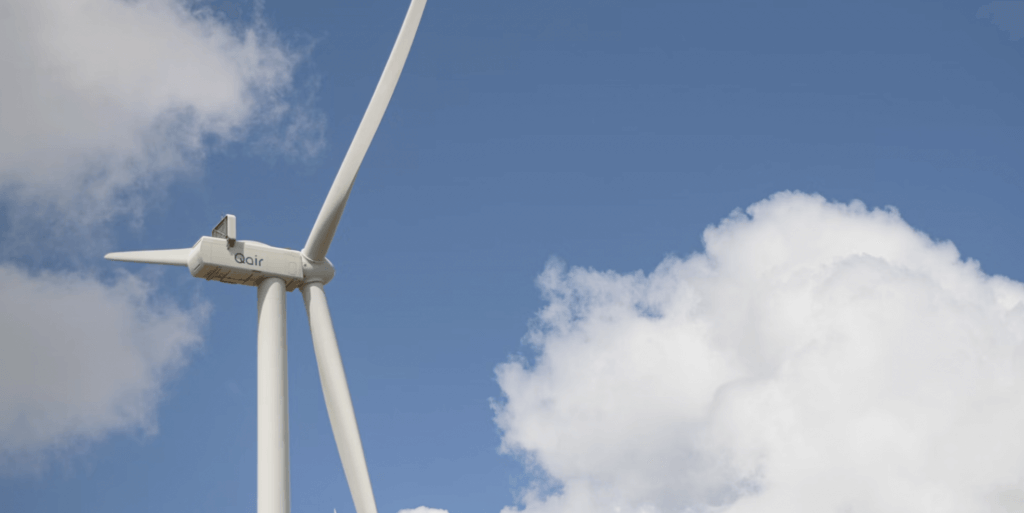
Reciclaje de turbinas eólicas: ¿podrían los proyectos al final de su vida útil dar esperanzas a la industria náutica?

La energía eólica, como cualquier otra energía renovable, es limpia, cada vez más barata y libre de emisiones, pero para que se considere verdaderamente verde es importante evaluar su impacto ambiental al final de su vida útil, afirma el experto en energía y científico a bordo de Energy Observer . Beatriz Cordiano.
Actualmente en su gira mundial de siete años para promover y probar nuevas soluciones de propulsión y energía sostenible, Energy Observer es un laboratorio para la transición ecológica, concebido para superar los límites de las tecnologías de cero emisiones. Hidrógeno, energía solar, eólica e hidroeléctrica: todas las soluciones han sido experimentadas, probadas y optimizadas a bordo, para hacer de las energías limpias una realidad práctica accesible para todos.
Aquí, Cordiano explora el acuciante problema de las turbinas eólicas que están llegando al final de su uso.
Ciclo de vida de la turbina eólica
Cuando las primeras turbinas eólicas comerciales entraron en funcionamiento a mediados y finales de los años 90, ahora están llegando al final de su vida operativa y deben ser desmanteladas. Esto plantea la cuestión de qué hacer con sus residuos.
En 2022, la capacidad total de todas las turbinas eólicas en todo el mundo superó los 906 GW, suficiente para proporcionar más del siete por ciento de la generación eléctrica mundial. Las turbinas eólicas son cada vez más altas, más grandes y más potentes, ofreciendo la posibilidad de obtener energía confiable y abundante.
Las turbinas eólicas no giran eternamente, están diseñadas para durar al menos 20 años y su vida útil puede aumentar si se les da el mantenimiento adecuado. Funcionan unas 7.500 horas al año, unas 150.000 horas o más durante su vida útil. Y, tarde o temprano, la exposición constante al viento y a las inclemencias del tiempo traerá efectos evidentes, por lo que será necesario dejarlos de utilizar. Eso es lo que está sucediendo con la ola inicial de instalaciones de turbinas eólicas –que, en Europa, se remonta a la década de 1990, principalmente en Alemania, Dinamarca y España– que hoy se acercan a la edad de jubilación.
Una vez que llega al final de su ciclo de vida, un aerogenerador presenta tres posibles líneas de acción: prolongar su funcionamiento de tres a cinco años, emprender una operación de repotenciación (la sustitución de turbinas antiguas por modelos más eficientes, que permitan aumentar la producción). del parque eólico sin necesidad de terreno adicional o, si ninguna de estas alternativas resulta viable, desmantelar el parque.
De aquí a 2030, se espera que unos 50.000 aerogeneradores alcancen o superen los 20 años de vida útil en Europa y, a partir de 2030, se añadirán otros 5.700 por año al tubo de desmantelamiento como consecuencia de la repotenciación. Surge una pregunta: ¿qué pasará con este stock envejecido y obsoleto?

Imagen cortesía de Energy Observer Productions – Agathe Roulin.
¿Se pueden reciclar las turbinas eólicas?
Existe la idea errónea de que los aerogeneradores son perjudiciales para el medio ambiente debido a sus componentes y que, por este motivo, son imposibles de reciclar. Esto es incorrecto: alrededor del 96 por ciento de una turbina eólica es reciclable. Para entender esto, podemos observar la composición de dicha tecnología.
Carcasa, ejes, engranajes y componentes eléctricos, una turbina eólica se compone de más de 8.000 piezas. Pero para hacerlo sencillo podemos dividirlo en cuatro partes, cada una con funciones específicas y por tanto materiales:
- Los cimientos, enterrados en el suelo, están hechos de hormigón y chatarra.
- La torre, que debe soportar la góndola y proporcionar acceso a ella, está hecha esencialmente de acero.
- Subiendo encontramos la góndola, que alberga el sistema de conversión de la energía mecánica del viento en electricidad y, por tanto, está constituida principalmente por componentes eléctricos.
- Y por último, el rotor –buje y palas– fabricado en una resina polimérica reforzada con fibra de vidrio y ocasionalmente fibra de carbón.
Si relacionamos estos materiales con el tonelaje del aerogenerador, encontramos que casi el 90 por ciento es acero y cemento, el seis por ciento es fibra de vidrio, sólo el tres por ciento son polímeros y el resto son metales y materiales electrónicos. Por tanto, la mayor parte es totalmente reciclable. En 2021, la tasa de reciclaje de aerogeneradores en Francia, excluidas las palas, se acercó al 98 por ciento (96 por ciento con las palas).

Parque eólico en Brasil. Imagen cortesía de Energy Observer Productions – Melanie de Groot.
Aspas: el talón de Aquiles de la energía eólica
Mientras que el hormigón puede triturarse, clasificarse y reciclarse como árido para otros tipos de hormigón, en particular para otras turbinas eólicas, o como relleno, y el acero puede reciclarse una y otra vez sin pérdida de propiedad, no ocurre lo mismo con el cuchillas. En la actualidad, las palas son el hueso duro del reciclaje de aerogeneradores. El problema de las palas es la forma en que están construidas. La fibra de vidrio está compuesta de finas hebras de plástico y vidrio, lo que hace que su reciclaje sea difícil y costoso.
Según las estimaciones, se espera que hasta 2025 se desmantelen 1 GW anualmente en Francia, lo que significa entre 3.000 y 15.000 toneladas de materiales compuestos por año. La cuestión del reciclaje de materiales compuestos no es exclusiva de la industria eólica, ya que los mismos materiales se utilizan en la industria del automóvil, el transporte marítimo y el ocio para piezas aeronáuticas, cascos de barcos e incluso esquís, pero se utiliza a menudo para desacreditar la sostenibilidad. de esta energía renovable. Aunque las palas son inertes y no producen emisiones tóxicas (por lo que son bastante seguras para los vertederos), su eliminación incontrolada sigue siendo un enorme desperdicio de recursos que se aleja de los criterios de sostenibilidad y circularidad. No se puede negar que muchas palas de primera generación acaban en vertederos, pero no en Europa, donde está estrictamente prohibido enterrar las palas de los aerogeneradores, pero no es el caso de todas.
Los fabricantes y operadores se están centrando en nuevos enfoques, tratando de encontrar formas de separar la matriz polimérica de las fibras de refuerzo para recuperar y reutilizar los materiales, o reconstruir nuevas palas utilizando materiales reciclables. De este modo, las palas eólicas pueden reutilizarse por completo como elementos estructurales, como parques infantiles, cobertizos para bicicletas, barreras acústicas o partes de proyectos de ingeniería civil. Se pueden reciclar de forma mecánica, triturar y, a menudo, reutilizar como material de relleno en edificios: un proceso que Veolia, la empresa francesa de gestión de recursos, domina utilizando materiales triturados de las palas como ingrediente para la producción de cemento. Pueden tratarse térmicamente, incinerarse y revalorizarse como combustible para la producción de energía y, en pocos casos, también pueden someterse a un proceso químico donde las fibras se separan de las resinas mediante disolventes y procesos térmicos.
En eso está trabajando Vestas , el fabricante danés de aerogeneradores, probando una tecnología puntera que descompone las palas en un líquido utilizando productos químicos económicos, no tóxicos y fácilmente disponibles, lo que permite producir materiales de alta calidad con poca energía. .
Otras iniciativas apuntan a modificar los materiales utilizados para fabricar las turbinas, con el objetivo de diseñar una nueva generación de palas fabricadas con termoplásticos que sean biodegradables o reconstituibles al final de su vida útil, haciendo que la fabricación de las palas sea más sostenible y más fácil de reciclar. Ese es el caso de las primeras palas totalmente reciclables en las que ha trabajado el consorcio ZEBRA (Zero wastE Blade ReseArch), produciéndolas en la fábrica de Ponferrada de LM Wind Power (España), antes de probarlas y comercializarlas en Dinamarca.
Siempre hay margen de mejora, sobre todo si se sigue trabajando en el ecodiseño de los componentes. Esta pala 100% reciclable es un paso importante y un avance prometedor que puede ayudar a lograr una mayor sostenibilidad en el sector de la energía eólica, mientras se espera crear una cadena de suministro altamente eficiente capaz de reciclar y mejorar todos los componentes.
No hace falta decir que, incluso si hoy en día la forma actual de las turbinas eólicas puede no ser perfecta, su impacto ambiental positivo supera con creces los negativos en el ciclo de vida general.
Este artículo fue publicado por el equipo de Energy Observer .
El post Reciclaje de turbinas eólicas: podría llegar al final de su vida útil¿Estos proyectos dan esperanza a la industria náutica? apareció por primera vez en Marine Industry News .
